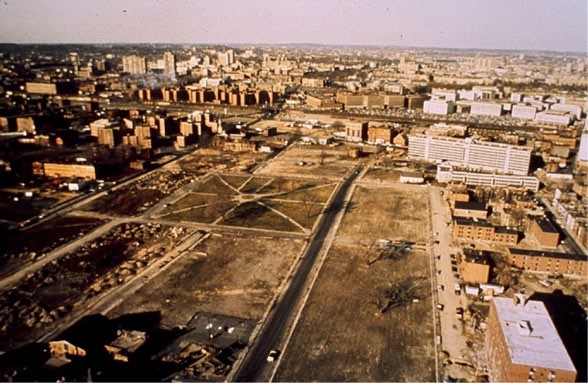Community-led Use of Eminent Domain

Clearing lots for building. Courtesy of cityminded.org
DSNI was the first community-based nonprofit in the country granted eminent domain authority over land within its boundaries. DSNI’s eminent domain authority applied to the vacant land in a 60-acre area called the “Dudley Triangle.”[1] Looking at a map of the neighborhood was like looking at a jigsaw puzzle. The city-owned land was hopelessly broken up by small, tax-delinquent properties, and vacant private lands were scattered throughout Dudley. Despite being tax-delinquent, acquiring the private land would require lengthy court battles. There would be no way to assemble a critical mass of the empty and delinquent property without a policy tool to streamline the process. [2]
The Dudley Triangle

Source: http://www.dudleyneighbors.org/maps.html
Because neighborhood residents had a deep-seated suspicion of city officials and private developers, the use of eminent domain by a central government authority would have met with considerable resistance and likely failure. However because DSNI had engaged in a community-led planning process and developed a plan aimed at protecting the interests of local residents and businesses and improving the community for them, it had support not present in many other eminent domain cases around the county. As the former Executive Director of DSNI, John Barros, explains:
"This part of the city wasn’t anything that anybody felt proud about. It was really causing a big problem in the neighborhood… The city was looking for wins in neighborhoods like ours to try to create some kind of relationship with neighborhoods of color. And they couldn’t use (eminent domain) in this neighborhood. They couldn’t use it because nobody would trust them. And so allowing a neighborhood organization to have built some credibility, still in its young days, but had a real robust process of engaging people, a collaborative board structure of multiple stakeholders in the neighborhood and maybe taking a chance with us using it might be the way to go."
Neighborhood control of eminent domain made it a community tool and not something imposed from the outside. Barros adds:
"The good thing was, this was neighbors talking to neighbors. This was not the city or somebody else come in and having a conversation. This was our neighborhood leaders. Residents who already lived here saying, ‘I’m sick of living next to trash. I’m sick of living next to rat infested vacant land. Weed infested, just really dirty places. I’m sick of living next to places where people dump their trash from around the city.’ So that conversation was a real conversation… it was their neighbors standing up and saying, ‘you know, hey, we think this is a tool to improve our neighborhood for all of us."
[1] The Dudley Street Neighborhood Initiative. Website. www.dsni.org/history. Accessed August 4, 2015
[2] Medoff and Sklar 1999

